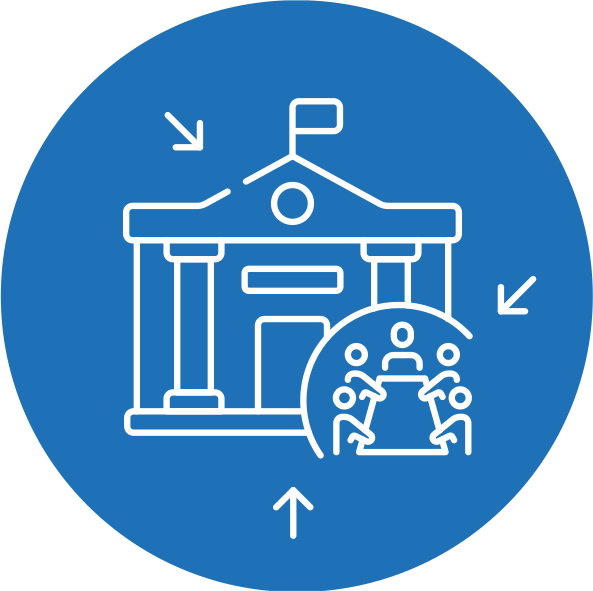
P1: Environmental protection and risk management
SO 1.1: enhancing protection and preservation of nature, biodiversity, and green infrastructure, including in urban areas, and reducing all forms of pollution
Types of actions:
• Investments in the field of natural resources, ecosystems and biodiversity, including technologies for environmental protection;
• Investments in protection of landscapes and implementation of measures to conserve and restore ecosystems, biodiversity, forestry and to protect wildlife;
• Development and implementation of conservation and protection measures of Natura 2000 sites on the Romanian side and equivalent natural protected areas on the Serbian side;
• Implementation of measures for reducing pollution and raising awareness (e.g. waste prevention, collection and treatment, sorting and 5R measures);
• Investments in activities dedicated to the control of pollution and rehabilitation of rivers and brownfields;
• Investments in activities dedicated to rehabilitation of industrial sites and contaminated land, support to the closure and rehabilitation of substandard and illegal landfill sites;
• Investments in measures improving air quality, air quality monitoring (e.g.: air quality monitoring networks) and noise reduction measures;
• Investments in green infrastructure mainly in urban areas (e.g. storm-water management, sustainable urban drainage systems (SUSDS), green streets, green roofs, permeable/porous paving, urban forests, natural cooling of buildings, subsurface detention, cisterns and rain barrels and blue and/or green infrastructure);
• Expanding green infrastructure that connects habitats, strengthens ecological corridors and protected sites, reducing landscape fragmentation and ensuring their recreational potential;
• Joint strategies and action plans tackling the issue of pollution, nature protection and biodiversity protection;
• Testing of new tools, instruments, experiments, transfer of solutions between relevant stakeholders and increasing the cross-border cooperation in the field of biodiversity, nature protection, green infrastructure and reducing pollution.
SO 1.2: promoting renewable energy in accordance with Directive (EU) 2018/2001, including the sustainability criteria set out therein
Types of actions:
• Solutions developed through joint “pilot actions” in renewable energy (e.g. wind, solar, geothermal).
SO 1.3: promoting energy efficiency and reducing greenhouse gas emissions
Types of actions
• Investments in energy efficiency measures regarding public infrastructure;
• Promotion of energy efficiency and resource efficiency measures;
• Demonstration projects and initiatives for reducing emissions of green-house gas and air pollutants;
• Investment in supporting measures for reducing emissions of green-house gas and air pollutants.
SO 1.4: promoting climate change adaptation and disaster risk prevention and resilience, taking into account eco-system based approaches
Types of actions
• Restoration of natural areas (e.g. forests, river banks) to prevent floods and land-slides;
• Development and implementation of measures such as restoration of Natura 2000 sites on the Romanian side and equivalent natural protected areas on the Serbian side, in relation to climate change impact;
• Afforestation and reforestation (e.g. protection forests) of the areas vulnerable to floods and land-slides;
• Development and implementation of measures and ecosystem-based approaches related to adaptation to climate change;
• Development and implementation of measures in relation to climate change mitigation solutions;
• Measures related to prevention and management of climate related risks, like: fires, storms, drought;
• Risk prevention and management of non-climate related natural risks (i.e. earthquakes) and risks linked to human activities (e.g. technological accidents), civil protection and disaster management systems and infrastructures;
• Development and implementation of awareness measures and training products in the field of environment and emergency preparedness, including for children/ youth to respond to emergency situations;
• Implementing joint works for flood prevention on Danube River, its tributary rivers and Danube basin, preferably with nature-based solutions;
• Joint strategies and action plans for preventing natural risks and for enhancing climate change adaptation;
• Development and implementation of awareness measures in the field of climate change;

P2: Social and economic development
SO 2.1: improving equal access to inclusive and quality services in education, training and lifelong learning through developing accessible infrastructure, including by fostering resilience for distance and on-line education and training
Types of actions
• Elaboration of working procedures, joint platforms, joint events for online education and training;
• Measures for developing highly technical skills and competences;
• Joint measures for improving the link between the labour market and the education and training system;
• Exchange of best practice or guidelines in the field of improving access to and the quality of education, training and lifelong learning across borders;
• Development and implementation of joint actions to support adaptation of youth to market needs (e.g. digital skills);
• Development and implementation of measures to ensure social inclusion and social innovation, as well as support for green and digital re-skilling and up-skilling;
• Development and implementation of measures to support the creation of resilient and sustainable jobs and the employment of people with vulnerable background;
• Investments in endowment of educational and training facilities;
• Investments in joint IT solutions that will facilitate on-line education and training;
• Investments in infrastructure and services for training, including technical and vocational and life-long learning.
SO 2.2: ensuring equal access to health care and fostering resilience of health systems, including primary care, and promoting the transition from institutional to family-based and community-based care
Types of actions
• Development and implementation of actions to support digitalization in healthcare and health mobile assets;
• Development and implementation of measures to improve accessibility effectiveness and resilience of healthcare systems and long-term care services across borders;
• Investments in building/renovation/endowment of healthcare facilities (including laboratories);
• Purchase of high-tech equipment for supporting telemedicine services;
• Investments in improving healthcare and long-term care services for the elderly, through home care and community based care services;
• Elaboration of joint working procedures, joint platforms, joint strategies for tackling cross-border medical threats;
• Know-how exchange and capacity building activities (joint trainings, conferences, workshops).
SO 2.3: enhancing the role of culture and sustainable tourism in economic development, social inclusion and social innovation
Types of actions
• Development and implementation of measures to develop and promote sustainable tourism assets and services, ensuring social inclusion and social innovation;
• Development and implementation of measures to protect, develop and promote natural heritage and eco-tourism, health tourism, business tourism, sport/ cyclo/ hiking-tourism;
• Development and implementation of measures to protect, develop and promote cultural heritage and cultural services;
• Investments in physical regeneration of cultural and touristic objectives, in the scope of their inclusion in the touristic and/ or cultural circuit;
• Joint actions in the field of development of sustainable touristic and cultural services.

P3: Increasing border management capacity
SO: enhance the institutional capacity of public authorities, in particular those mandated to manage a specific territory, and of stakeholders
Types of actions
• Development and implementation of measures for strengthening of institutional capacities for improvement of services in the field of border management;
• Sharing experiences, guidelines and procedures for improving assessment, prevention, preparedness and response in case of pandemics and emerging infectious diseases;
• Joint trainings of border police personnel, as well as exchange of best practices and know-how on specific areas of activity;
• Developing common policies and strategies in the field of border management;
• Investments in infrastructure and equipment for effective border surveillance, control and migration management;
• Development and implementation of innovative solutions that utilize state-of-the-art technologies and large-scale IT systems to improve interoperability, security, convenience, waiting times and cost-effectiveness;
• Development and implementation of measures to reduce vulnerability of the border and guarantee safe, secure and well-functioning border management.
